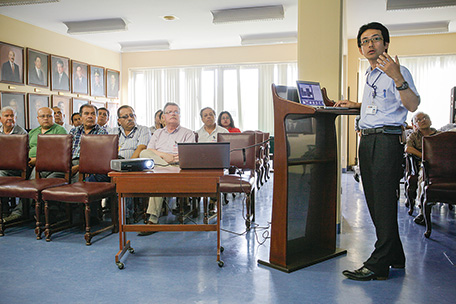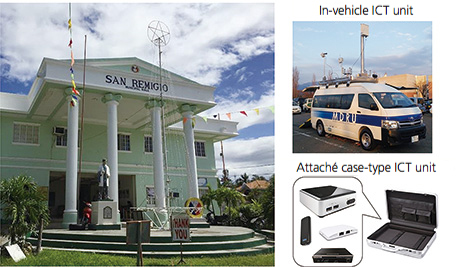(5) Introduction of Information and Communications Technology (ICT) and High Technology
The dissemination of Information and Communications Technology (ICT)* contributes to the achievement of sustainable economic growth by upgrading industries and improving productivity. It also contributes to addressing issues related to medical care, education, energy, environment, disaster risk reduction, and other social issues in developing countries. Utilization of ICT improves their democratic foundation through encouraging information disclosure by governments, and developing broadcasting media. In this way, ICT is extremely important for strengthening civil society through increased convenience and improved services, and for quality growth.
< Japan’s Efforts >
Japan actively offers assistance mainly for the development of communications and broadcasting equipment and facilities in developing countries, the introduction of the technology and systems they require, and relevant human resources development, in order to eliminate the ICT disparities that exist between countries and regions and to help improve the quality of life of all people.
More specifically, Japan makes proactive efforts to provide comprehensive support for the overseas promotion of Integrated Services Digital Broadcasting-Terrestrial (ISDB-T)* in the areas of maintenance, personnel and systems, which is also an effective means for contributing to Japan’s economic growth. As of August 2015, ISDB-T has been introduced in Latin America and the Caribbean, Asia and Africa, and has been adopted in a total of 17 countries.(Note 6) Japan has dispatched experts to eight countries, including the Philippines, Ecuador and Costa Rica, and has been transferring technologies since FY2009 as part of the support to countries adopting ISDB-T. A JICA training program is conducted every year for countries adopting ISTB-T and those considering to adopt it to promote the overseas spread and introduction of ISDB-T.

A JICA Expert, Mr. Katsumasa Hirose delivers a presentation at the Ministry of Transport and Communications of Peru in Lima on digital terrestrial broadcasting to promote its introduction for speedy communication of disaster information via TV in the event of natural disasters. (Photo: Kosuke Okahara / JICA)
To increase the adoption of ISDB-T in other countries, the Ministry of Internal Affairs and Communications (MIC) extends assistance that offers ICT solutions resolving social issues by way of dialogues and joint projects with partner governments. Furthermore, MIC contributes in the field of ICT for disaster risk reduction. Japan’s ICT for disaster risk reduction makes it possible to collect, analyze and distribute disaster information in an integrated manner, allowing detailed information to be communicated swiftly and infallibly at the community level, including to the public.
MIC will continue to cooperate in the field of ICT for disaster risk reduction, and thereby contribute to increasing the disaster risk reduction capabilities of developing countries. (See this for more information on disaster risk reduction.)
Japan also actively collaborates with international organizations to carry out these efforts. Japan works with the International Telecommunication Union (ITU),* a specialized agency of the UN responsible for telecommunications, to provide a variety of development assistance in the field of telecommunications to developing countries. In December 2014, Japan collaborated with ITU and the Government of the Philippines to commence a joint project in Cebu Island, the Philippines, where a typhoon caused catastrophic damages in 2013. The project conducts demonstration tests using the Movable and Deployable ICT Resource Unit (MDRU),* a system capable of quickly restoring information and communications as an emergency measure in the wake of natural disasters. Additionally, from November to December 2015, the Japanese government and ITU held the World Telecommunication/ICT Indicators Symposium (WTIS) in Hiroshima. At this annual symposium attended by many ministers, discussions took place on the role of ICT in relation to the development goals in the 2030 Agenda for Sustainable Development, which was adopted at the UN General Assembly in September 2015. The ICT Development Index that holistically evaluates each country’s level of ICT access, use, and skills was also presented.
In the Asia-Pacific region, the international organization for the information and communications sector known as the Asia-Pacific Telecommunity (APT)* has served as a coordinator of regional policy. At the APT Ministerial Meeting in Brunei in September 2014, APT adopted a joint statement for member states and APT to cooperate on building a “smart digital economy” in the Asia-Pacific region. Their efforts have contributed to a balanced development of telecommunication services and information infrastructure within the region. To reduce ICT disparities and solve social issues facing developing countries, including disaster risk reduction and medical care, Japan has supported through APT human resources development such as training in the ICT field, and exchange of ICT engineers and researchers.
In June 2014, APT held a workshop in Tokyo on disaster management and communications. Participants shared their know-how and experiences on themes such as the effectiveness and use of emergency communications and warning systems, and exchanged views on future challenges and efforts.
As regards the Association of Southeast Asian Nations (ASEAN), the ASEAN Community was established on December 31, 2015, which aims to create a symbiotic society and a single market covering 600 million people. At the ASEAN Summit in November 2015, ASEAN adopted new blueprints that provide new indicators to 2025. This blueprint identifies ICT as a key driver in ASEAN’s economic and social transformation. In light of the importance of ICT’s role, the ASEAN ICT Masterplan 2020 (AIM2020) that serves as ASEAN’s ICT strategy towards 2020 was formulated at the Japan-ASEAN Telecommunications and Information Technology Ministers (TELMIN) Meeting held in the same month. Based on these developments, at the TELMIN Meeting, Japan introduced the ASEAN Smart ICT Connectivity (ASIC) that outlines Japan’s cooperation vision for ASEAN. Japan will continue to support the development of ICT in ASEAN and efforts to offer ICT solutions to regional issues. In order to put this vision into practice, Japan supports the development of ICT infrastructure in Myanmar using ODA, and in such ways, extends cooperation in the field of ICT. With regard to the issues of cyber-attacks that have become key concerns of countries in recent years, Japan and ASEAN have agreed to further deepen their cooperation in the information security field, which has included the holding of the eighth ASEAN-Japan Information Security Policy Meeting in October 2015 in Jakarta, Indonesia.
- *Information and Communications Technology (ICT)
- ICT is technology that integrates computers and other information technology with digital communication technology, as characterized by the Internet and mobile phones.
- *Integrated Services Digital Broadcasting – Terrestrial (ISDB-T)
- ISDB-T is a terrestrial digital broadcasting system that was developed in Japan. Its functions, such as emergency alert broadcast, TV reception on mobile terminals, and data broadcasting, give the system advantages in disaster response and the realization of diverse services.
- *International Telecommunication Union (ITU)
- ITU is a UN specialized agency, which is responsible for the fields of telecommunications and broadcasting (HQ: Geneva, Switzerland; 193 member countries). To ensure that people around the world are able to make use of telecommunications technologies, ITU implements: (i) the international allocation of radio frequencies used in mobile phones, satellite broadcasting, and other technologies; (ii) the international standardization of telecommunications technologies; and (iii) support for development in the field of telecommunications in developing countries.
- *Movable and Deployable ICT Resource Unit (MDRU)
- MDRU is a telecommunications facility that was researched and developed by MIC based on the lessons learned from the Great East Japan Earthquake. The unit is deployed to affected areas in the wake of a natural disaster to quickly restore communications as an emergency measure. The unit can be made smaller, such as the vehicle-based type and the attaché case type. MDRU allows for phone services and data communications to take place when communications equipment have been damaged and cannot be utilized.
- *Asia-Pacific Telecommunity (APT)
- APT is an international telecommunications organization established in the Asia-Pacific region in 1979, made up of 38 member countries. Aiming for a balanced development of telecommunication services and information infrastructure in the Asia-Pacific region, it develops human resources through training sessions and seminars and coordinates regional policies on standardization, wireless communications, and other telecommunication issues.
- Note 6: The 17 countries are Brazil, Peru, Argentina, Chile, Venezuela, Ecuador, Costa Rica, Paraguay, the Philippines, Bolivia, Uruguay, Maldives, Botswana, Guatemala, Honduras, Sri Lanka and Nicaragua (as of August 2015).
The Philippines
Joint Project with the ITU on Moveable and Deployable ICT Resource Units
Ministry of Internal Affairs and Communications Technical Cooperation (December 2014 – Ongoing)

San Remegio City Hall where the project is implemented, and vehicle-type and attaché case-type mobile ICT units. (Photos: MIC)
Typhoon Haiyan, a large-scale typhoon, struck the Philippines and caused extensive damage in Cebu Island in the Philippines in November 2013. The municipality of San Remigio in the northern part of Cebu Island was directly hit by the typhoon, and its wireless networks were completely wiped out. In the immediate aftermath of the typhoon, people were forced to gather information manually. Moreover, a single satellite phone used by the mayor was the only means of communicating with the outside world, including for reporting the damage to the national government. This highlighted the pressing need for mitigation of risks associated with a natural disaster.
Under these circumstances, the Government of Japan and the International Telecommunication Union (ITU) responded to the request from the Government of the Philippines, and commenced a joint project to perform a feasibility study using a Movable and Deployable ICT Resource Unit (MDRU) for disaster mitigation in the municipality of San Remigio in December 2014.
An MDRU is a mobile telecommunication facility which can be quickly transported for emergency rehabilitation of the communication system in an affected-area during a disaster. The facility has been developed based on the lessons learned from the Great East Japan Earthquake by the Nippon Telegraph and Telephone Corporation (NTT) and other companies commissioned by the Ministry of Internal Affairs and Communications (MIC) since 2011. MDRUs come in the form of a vehicle-based unit and a briefcase-type unit, making them easy to transport to an area hit by a natural disaster. Even when existing telecommunication equipment is damaged and unusable, an MDRU can be quickly set up locally to connect telephone calls and establish an Internet connection.
During the feasibility study, an MDRU was placed at city hall to establish a wide-area Wi-Fi network between the emergency response headquarters and evacuation sites (approximately 500 meters). Next, smartphones were used to make calls and share data such as pictures and videos. This proved that the MDRU worked effectively in the Philippines and could be used for future disasters. City employees and local residents then received technical training on how to properly operate and manage the MDRU on a daily basis. They also participated in a training drill using the MDRU based on the scenario that a major natural disaster had occurred. These efforts have greatly contributed to the municipality’s disaster mitigation preparations.
In the future, the results of the feasibility study will be shared in Japan and abroad so that the MDRU can be introduced and used in other places as well. Japan will continue to work together with the ITU and other international organizations to improve natural disaster planning not only in the Philippines, but also other countries around the world. (As of August 2015)
